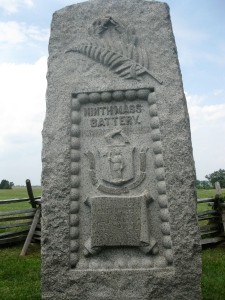Bruce Catton, The Coming Fury: Volume I, The Centennial History of the Civil War. New York: Doubleday, 1961. (part two)
One hundred and fifty years ago today, Captain Bigelow’s Ninth Massachusetts Battery made an important stand at the Peach Orchard and Trostle’s Farm, Gettysburg. Bigelow’s battery, never before in combat, was ordered to help the III Corps of Daniel Sickles hold advancing Confederate forces at bay as the Union army pulled its forces back into defensible positions on the second day at Gettysburg.
This fighting at Gettysburg took place because of the dissolution of the Union, which Bruce Catton describes in great detail beginning with chapter three of The Coming Fury. Catton describes a Union that is drifting towards war despite the fact that most people in the United States (even those in the soon to be seceded states) wanted to remain at peace. Catton then uses speeches and personalities from the South Carolina secession convention to illustrate the desire for independence, but, in a peaceful way if at all possible. He describes then President James Buchanan as the “unhappiest man in America” which seems like an understatement given Buchanan’s reaction when told about secession – ‘he looked at me stunned’ wrote a witness, and rode off to the White House to face the crisis (140). This kind of theater in writing, despite covering ground that students of history might know, is highly effective.
The next stage of the crisis, that regarding Federal property in the seceded states is an interesting section as well. As is typical of his style, Catton gives us much to think about regarding the personalities involved and he fleshes out an important question. Why does South Carolina assume the right to own these federal properties? It is one thing to claim the right to secede, but is it not something entirely different to claim the right to property owned by a separate governing body, simply due to geographic location? And this is to say nothing of the men, materials, etc. within armories and forts, etc. The back and forth between the Buchanan administration and the government of South Carolina is uncovered in fascinating detail.
The fourth chapter of Fury depicts the rival presidents, Jefferson Davis and Abraham Lincoln, as each takes the reins of their respective governments. Catton points out that the Southern position is a bit unsteady as a little less than half of the slave states initially seceded. Again, a mixture of speeches, documents, and newspaper accounts give the reader a sense of the times. The book itself revealed a little more recent history to me too – a bookmark in chapter four (page 226, “Colonel Lee Leaves Texas”) proved to be a selective service system notice of classification card for a young man from Hartford, CT. I’m fairly certain this individual (declared 1-A which meant available for military service) was my father’s freshman year roommate – the book has held this card for some fifty-two years!
Finally, the chapter concludes with Lincoln’s inaugural address – in it, Lincoln points out that the Union was unbroken. It was together, despite any actions taken at Charleston, Montgomery, or anywhere else. Lincoln reminded the audience that “he was its (the Union’s) chief executive, and he would behave accordingly” (265). Lincoln confirmed what many had suspected – he would “hold, occupy, and possess the government’s property.” Clearly, Lincoln meant that the United States was not to surrender Fort Sumter or any other locations without a fight (266-270).

